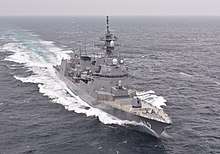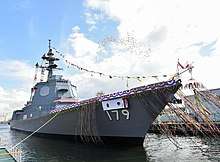List of destroyers of Japan
The following is a list of destroyers and 1st class (steam) torpedo boats of Japan grouped by class or design. Each ship's name is followed by its launch date in brackets. In naval terminology, a destroyer is a fast and maneuverable yet long-endurance warship intended to escort larger vessels in a fleet, convoy or battle group and defend them against smaller, powerful, short-range attackers. The Japanese torpedo boat[1] Kotaka of 1885 was "the forerunner of torpedo boat destroyers that appeared a decade later".[2] They were designed to Japanese specifications and ordered from the London Yarrow shipyards in 1885. The Yarrow shipyards, builder of the parts for the Kotaka, "considered Japan to have effectively invented the destroyer".[3]
Imperial Japanese Navy
Russo-Japanese War
These twenty-three 'turtle-back' destroyers, all authorised under the Ten Year Naval Expansion Programme of 1898, comprised six Ikazuchi class built by Yarrow[4] and six Murakumo class built by Thornycroft[5] in the UK, each carrying 1 - 12pdr (aft) and 5 - 6pdr guns and 2 - 18in torpedo tubes, and followed by two larger ships from each of the same builders (the Shirakumo class from Thornycroft and the Akatsuki class from Yarrow), in which a second 12pdr replaced the foremost 6pdr, and finally by seven Harusame class built in Japan. All were later rated as 3rd Class destroyers (under 600 tons each). The Programme also included sixteen First Class torpedo boats, included below (47 smaller 2nd and 3rd Class boats from this Programme are not included)
Murakumo class — 6 ships
|
|
Ikazuchi class — 6 ships
|
|
Shirataka class - 1 1st class torpedo boat
- Shirataka (10 June 1899)
Hayabusa class - 15 1st class torpedo boats
|
|
Shirakumo class — 2 ships
|
|
Akatsuki class — 2 ships
|
|
Harusame class — 7 ships
|
|
World War I
Before and during World War I, Japan established three grades of destroyers - the large (over 1,000 tons) 1st Class or ocean-going type, the medium (600 to 1,000 tons) 2nd Class type and the small (below 600 tons) 3rd Class type. Between 1904 and 1918, Japan built thirty-two 3rd Class destroyers (the Kamikaze class), twenty-two 2nd Class destroyers (the Sakura, Kaba, Momo and Enoki classes) and eight 1st Class destroyers (the Umikaze, Isokaze and Kawakaze classes). They also purchased two further 1st Class destroyers (the Urakaze class) built in the UK by Yarrow.
Kamikaze class — 32 ships
|
|
Umikaze class — 2 ships
|
|
Sakura class — 2 ships
Kaba class — 10 ships
|
|
Urakaze class — 2 ships
Momo class — 4 ships
|
|
Isokaze class — 4 ships
|
|
Acorn class/Kanran class - 2 ships
(both ships loaned from the Royal Navy from June 1917 to 1919)
|
|
Kawakaze class — 2 ships
|
|
Enoki class — 6 ships
|
|
The Inter-War Period
From 1919 onwards, a series of destroyers were built regularly in Japan. No further 3rd Class ships were built after 1909, and only two further classes of 2nd Class ships (the Momi and Wakatake classes) were built by 1923, after which all were 1st Class. The ships of the Wakatake, Kamikaze and Mutsuki classes were initially given numbers rather than names, but names were assigned on 1 August 1928. The numbering system continued after 1928, but were not assigned to ships, which were all named.
Momi class — 21 ships
The total of 21 excludes 7 cancelled. (Warabi lost in August 1927; Momi, Kaya and Nashi scrapped by 1940, leaving 17 which served in the Pacific War)
|
|
Minekaze class — 15 ships
|
|
Wakatake class — 8 ships
The total of 8 excludes 5 cancelled in 1922. (Sawarabi lost in December 1932; leaving 7 which served in the Pacific War)
|
|
Kamikaze class — 9 ships
Mutsuki class — 12 ships
|
|
Fubuki class (Special Type)— 20 ships
(Miyuki lost in 1934, leaving 19 which served in the Pacific War)
|
|
Akatsuki class — 4 ships
Hatsuharu class — 6 ships
Chidori class — 4 ships
These four vessels were nominally "torpedo boats". Built under the 1st Naval Armaments Supplement Programme of 1931.
|
|
The Second Sino-Japanese War and World War II
Ōtori class — 8 ships
These eight vessels were nominally "torpedo boats". The total of 8 excludes another 8 cancelled units.[8]
|
|
Shiratsuyu class — 10 ships
|
|
Asashio class — 10 ships
|
|
Kagerō class (Type A) — 19 ships
|
|
Akizuki class (Type B) — 12 ships
The total of 12 excludes 1 uncompleted (Michitsuki) and 3 cancelled; 21 intended further ships were never ordered.[9]
|
|
Yūgumo class (Type A) — 19 ships
The total of 19 excludes 8 cancelled.[10]
|
|
Shimakaze class (Type C) — 1 ship
The total excludes 16 cancelled.[11]
- (No.119)/Shimakaze (18 July 1942)
Matsu class (Type D)— 18 ships
|
|
Tachibana class (Modified Matsu - Type D Kai) — 23 ships
The total includes 9 never completed but excludes cancelled units
|
|
Japan Maritime Self-Defense Force
Standard Destroyer
_underway_in_1959.jpg)
Gleaves class/Asakaze class (DD) — 2 ships transferred 1954 from USA
|
|
Fletcher class/Ariake class (DD) — 2 ships transferred 1959 from USA
|
|
Harukaze class (DD) — 2 ships
|
|
Ayanami class (DDK) — 7 ships
|
|
Murasame class (1958) (DDA) — 3 ships
|
|
Akizuki class (1959) (DD) — 2 ships
|
|
Yamagumo class (DDK) — 6 ships
|
|
Takatsuki class (DDA) — 4 ships
|
|
Minegumo class (DDK) — 3 ships
|
|
Hatsuyuki class (DD) — 12 ships
|
|
Asagiri class (DD) — 8 ships
|
|
Murasame class (1994) (DD) — 9 ships
(orders for 5 more were replaced by those for the succeeding Takanami class)
|
|
Takanami class (DD) — 5 ships

|
|
Akizuki class (DD) — 4 ships
|
|
Asahi class (DD) — 2 ships
|
|
Guided Missile Destroyer
.jpg)
JDS Amatsukaze (DDG) — 1 ship
- DDG-163 Amatsukaze (5 October 1963)
Tachikaze class (DDG) — 3 ships
|
|
Hatakaze class (DDG) — 2 ships
|
|

Kongō class (DDG) — 4 ships
|
|
Atago class (DDG) — 2 ships
|
|
Maya class (DDG) — 2 ships
|
|
Helicopter Destroyer
.jpg)
Haruna class (DDH) — 2 ships
|
|
Shirane class (DDH) — 2 ships
|
|
Hyūga class (DDH) — 2 ships
|
|
.jpg)
Izumo class (DDH) — 2 ships
(Re-designated as multi-purpose operation destroyer)[12]
|
|
Escort Destroyer
.jpg)
Tachibana class — 1 ship
- DE-261 Wakaba (formerly IJN destroyer Nashi)
Cannon class (DE) — 2 ships transferred 1955 from USA
|
|
JDS Akebono (DE) - 1 ship
- DE-201 Akebono (30 October 1955)
Ikazuchi class (DE) — 2 ships
|
|
Isuzu class (DE)— 4 ships
|
|
Chikugo class (DE)— 11 ships
|
|
JDS Ishikari (DE) - 1 ship
- DE-226 Ishikari (18 March 1980)
Yubari class (DE)— 2 ships
|
|
Abukuma class (DE)— 6 ships
|
|
References
- Jentschura p. 132 (Akatsuki built by Yarrow & Co. in 1902; 224' long, displaced 415 tons, two 18" Torpedoes, two 3" guns, four 57mm Quick Firing Guns, complement 60 officers/men. Sunk by mine at Port Arthur on 17 May 1904)
- Evans and Peattie, David C. and Mark R. (1997). Kaigun: Strategy, Tactics, and Technology in the Imperial Japanese Navy, 1887–1941. Annapolis, Maryland: Naval Institute Press. ISBN 0-87021-192-7.
- Howe, Christopher (1996). The Origins of Japanese Trade Supremacy: Development and Technology in Asia from 1540 to the Pacific War. Chicago, Illinois: University of Chicago Press. ISBN 0-226-35485-7.
- Yarrow & Company, Poplar, London.
- John I. Thornycroft & Company, Chiswick, London.
- sold to Italy ten days after her launching as Audace.
- a replacement for the ship of the same name sold to Italy.
- The cancelled units, Torpedo boats #13 to #20 under the 1934 Programme, were projected to have been named Hatsutaka, Aotaka, Wakataka, Kumataka, Yamadori, Mizudori, Umidori and Komadori; however, no contracts were placed by the time the order was changed in 1937 in favour of Submarine chasers #4 to #11.
- Cancelled ships were 3 from the 1941 Programme (#367 to #369), to have been named Kiyotsuki, Ōtsuki and Hazuki. The 1942 Programme included another 16 Type B ships of an improved 2,933 ton design (#770 to #785) but this entire programme was cancelled; instead the Modified 5th Naval Armaments Supplement Programme included another 23 Type B ships of an even more improved 2,701 ton design (#5061 to #5083) but these were all cancelled before being laid down.
- Cancelled ships were 8 from 1941 Programme (#348 to #355). These would have been named Kiyokaze, Murakaze, Satokaze, Taekaze, Kawagiri, Tanigiri, Umagiri and Yamagiri. The Modified 5th Naval Armaments Supplement Programme included another 8 Type A ships of a slightly improved design (#5041 to #5048) but these were all cancelled before being laid down.
- The 16 units were ordered as #733-#748 under the 1942 Programme but were cancelled without being laid down.
- "Japan avoids flak by refusing to call flattop 'aircraft carrier'". The Asahi Shimbun. 6 December 2018. Archived from the original on 9 December 2018. Retrieved 29 December 2018.
- Jentschura, Hansgeorg & Jung, Dieter & Mickel, Peter. Warships of the Imperial Japanese Navy, 1869-1945. Arms & Armour Press, 1977. ISBN 1-85409-525-0.
- Stille, Mark. Imperial Japanese Navy Destroyers 1919-45 (1) - Minekaze to Shiratsuyu Classes. Osprey Publishing (No. 198), 2013. ISBN 978-1-84908-984-5
- Stille, Mark. Imperial Japanese Navy Destroyers 1919-45 (2) - Asashio to Tachibana Classes. Osprey Publishing (No. 202), 2013. ISBN 978-1-84908-987-6
- Stille, Mark. Imperial Japanese Navy Antisubmarine Escorts 1941-45. Osprey Publishing (No. 248), 2017. ISBN 978-1-4728-1816-4
- Watts, Anthony J. Japanese Warships of World War II. Ian Allan Ltd, London, 1966.
- Whitley, M. J. Destroyers of World War Two: An International Encyclopedia. Arms & Armour Press, 2000. ISBN 1-85409-521-8.